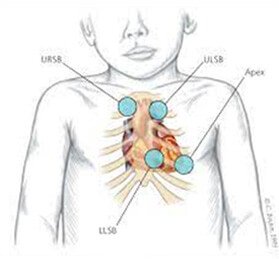Understanding Heart Murmurs in Babies
August 25, 2022 | Contributed by Srivatsan Rangachari
It is important to understand heart murmurs, what they are and when they can be a symptom of a heart disease in children.

Murmur is a Latin word defined as turbulence due to sound of blood flow audible as a prolonged series of varying intensity, frequency, configuration and duration detectable over precordium with the aid of a stethoscope1. In simpler words, heart murmurs are sounds made because of an abnormal or turbulent blood flow in the heart. These can be heard with a stethoscope and are in the range of 20-2000HZ (audible sound range).
In children, heart murmurs are sometimes common and may not indicate a health problem. These murmurs which do not indicate any underlying medical condition are called innocent or physiological murmurs. At other times murmurs may be a symptom of an underlying heart defect such as a heart disease in children and are then called pathological murmurs. It is therefore critical to get murmurs clinically evaluated by a doctor. Many children have an innocent murmur at some point of time. In some cases, the murmur maybe a sign a heart disease in children but may not require an intervention. It is thus vital to get heart murmurs clinically evaluated by a doctor.
Both physiological and pathological murmurs increase or become prominent in the presence of high output states.
Most murmurs heard after the first year of life are systolic and innocent. Some of the physiological murmurs appear at specific periods that show the hemodynamic (dynamics of blood flow) alterations pertaining to that age. In neonates, for example, a high Pulmonary Vascular Resistance Index (PVRI) is common, and the branch Pulmonary Arteries are relatively smaller in size. Hence Physiological TR and peripheral PS murmur are common at that age.
Similarly, pulmonary ejection murmur is common in childhood as well as during the adolescent years in view of thin chest wall and hyper dynamic circulation.
Types of Heart Murmurs
Heart Murmurs can be classified into different types:
- Systolic: These occur when the heart muscles contract. Usually, systolic murmurs except for Venous hum and mammary souffle are continuous in nature. These are more common on the right side of the heart across RV outflow than on the left side. At different points of age, various innocent murmurs are audible.
- Diastolic: These occur upon the expansion of heart muscles.
When do Murmurs become a cause of concern

When the murmur is diastolic, or a loud systolic (grade 3 or more) long duration with transmission to other parts, and there are additional associated symptoms such as altered pulses, cyanosis, associated pathological sounds or abnormal ECG/CXR, it is pathological and requires thorough careful cardiac evaluation.
In infants particularly apart from physiological murmur, any turbulent sound associated with a significant clinical finding and in an unusual position and character should raise suspicion of a pathological murmur. Heart murmur within a few hours of birth indicates semilunar valve stenotic lesions like Aortic or pulmonary valve stenosis, AV valve regurgitation and small shunt lesions like PDA.
Some of the main causes of heart murmurs are as follows:
Most of the murmurs are produced either due to the high velocity of blood producing a turbulent flow or due to the decreased chamber/vessel effective orifice.
Another factor that may cause murmur production is low kinetic velocity (hyperdynamic circulation) as seen in Anemia. This turbulence happens when the Reynolds number (Used to measure the turbulence of any liquid) reaches more than 2000. Various physiological mechanisms explain the origin of turbulence and hence murmur. These mechanisms are Vortex shedding, Jet impact, cavitations (micro bubbles), currents around the jet, periodic wake phenomenon and Flitter.
In infants, feeding difficulties may be the first sign of heart disease in children. This symptom is present in approximately one-third of infants and children with CHD. The most common symptoms in a series of children presenting to the emergency department with acute heart failure included dyspnea (74 %), nausea and vomiting (60 %), fatigue (56 %), and cough (40 %)2.
To determine the cause for the presenting murmur, it must be evaluated on certain points which will help doctors to narrow down the possibilities while taking into consideration clinical history, examination and the setting which produces turbulent sound.
Genesis Foundation (www.genesis-foundation.net) is a not-for-profit organazation supporting the treatment of less privileged children with Congenital Heart Defects including treatment for hole in heart of infants.
References:
- Frank JE, Jacobe KM. Evaluation, and management of heart murmurs in children. AM Fam Physician
- Pelech AN. Evaluation of the pediatric patient with cardiac murmur

